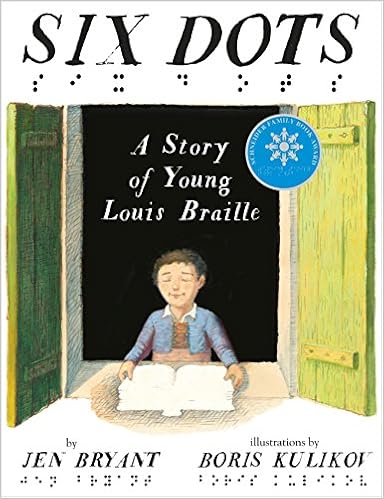Did you know World Braille Day is celebrated every year on January 4? January 4 is Louis Braille’s birthday, the inventor of braille! Blind people can read this language with their fingertips.
I would like to ask you to check out Skin and the Sense of Touch which goes into more detail on this, while Eye Defects shows various ways braille is used everyday.
Here are books which will allow you to continue teaching your students about Braille.
Six Dots: A Story of Young Louis Braille

Even at the school for the blind in Paris, there were no books for him.
And so he invented his own alphabet—a whole new system for writing that could be read by touch. A system so ingenious that it is still used by the blind community today.
Award-winning writer Jen Bryant tells Braille’s inspiring story with a lively and accessible text, filled with the sounds, the smells, and the touch of Louis’s world. Boris Kulikov’s inspired paintings help readers to understand what Louis lost, and what he was determined to gain back through books.
An author’s note and additional resources at the end of the book complement the simple story and offer more information for parents and teachers.

Take a walk on the wild side with DK Braille: Animals.
Learn about lions, elephants, koalas, and more in this exciting reference book designed specifically for blind or visually impaired readers. The pages combine braille, large print, and high-contrast photography with clear and predictive layouts for curious young readers. The images are large and embossed, flocked, or glossed with explanatory text, and the text is both embossed braille and printed in large text format for a shared reading experience for sighted readers.
DK Braille: Animals is a unique reference book that presents an exciting introduction to the animal kingdom for inquiring young minds.
A flagship series of high-quality, custom books with braille and tactile images for blind and partially sighted children, or sighted children with blind parents. DK Braille books combine uncontracted Unified English Braille and large type with high-contrast colors, embossed images, and tactile cutout shapes for children to feel with their fingers. The combination of text alongside the braille enables sighted parents to share the reading experience with visually impaired children, and for sighted children to share with their visually impaired parents.
Lesson Plans:
Introduce the wonders of braille to your sighted or low-vision learners. They can use this braille alphabet card to practice reading or writing in braille.
Students translate 7 words into Braille and write a message to a friend.
Thank you,
Glenda, Charlie and David Cates